“I’ve been absolutely terrified every moment of my life — and I’ve never let it keep me from doing a single thing I wanted to do.”
— Georgia O’Keeffe (1887 – 1986)
.
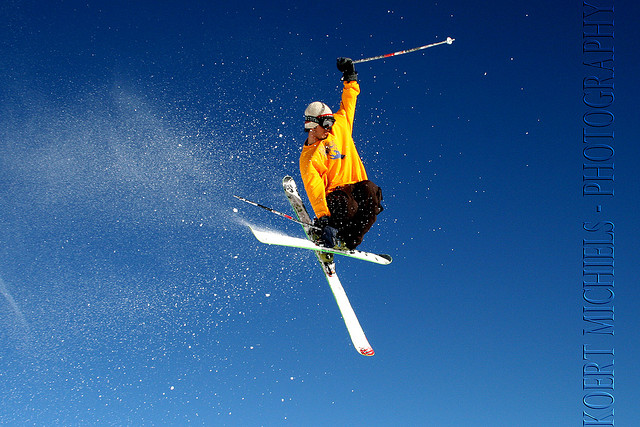
As we closed Bellavitae last year, I wrote a blog post titled “Six Magical Years“, which concluded: “So what happens next? All I can say is look for Bellavitae in the future – and look in unexpected places.”
Well, here I am.

Back to my beloved Southwest, but this time instead of the Sonoran Desert, I live nearly 10,000 feet above sea level, nestled within the Sangre de Cristo Mountains in northern New Mexico – in a charming village named Taos Ski Valley.
Mysterious and spiritual, dramatic yet peaceful – the scenery in this distant setting is simply breathtaking. Taos is full of juxtapositions – of contrasts really – that give one pause. This is a place where extreme skiers, hardy mountaineers, nature lovers, creative artists, haute cuisine, and native peoples live in harmony.
.
The Blonde Bear Tavern
We’ve come to Taos Ski Valley to re-create The Blonde Bear Tavern, a restaurant and wine bar within the Edelweiss Lodge and Spa. Joining me are Chefs Sophia Vigil, Josh Tate, and consulting Chef Andreas Dirnagl. Rounding out our team is Wine Manager and Mixologist Rushan Perera.
Skiing originated in Europe and was refined in world-famous resorts throughout the Alps. Our menu gives a taste of classic dishes from those regions interpreted through the casual laid-back attitude for which the Taos Ski Valley is known.
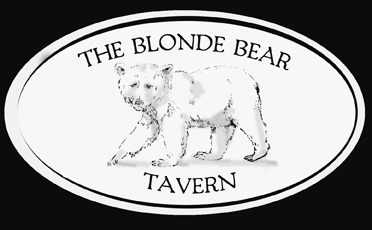 We call it Alpine Comfort Food. The flavors are very familiar to the American palate, but the origins – like those of Taos Ski Valley – are European. We add some American classic dishes too. When designing the menu, I asked myself, “After skiing one of the world’s famously challenging mountains, what would I want to eat?”
We call it Alpine Comfort Food. The flavors are very familiar to the American palate, but the origins – like those of Taos Ski Valley – are European. We add some American classic dishes too. When designing the menu, I asked myself, “After skiing one of the world’s famously challenging mountains, what would I want to eat?”
Our from-scratch menu uses ingredients sourced locally in New Mexico whenever possible, with an emphasis on organic producers.
.
Taos Ski Valley
Some 15 miles northeast from and 2,200 feet higher than Taos is the village of Taos Ski Valley. The village lies at an elevation of 9,207 feet; however, it reaches elevations of 12,581 feet with the highest residential dwelling at 10,350 feet, making Taos Ski Valley the highest municipality in the United States. Wheeler Peak, the tallest mountain in New Mexico at 13,161 feet, overlooks the village.
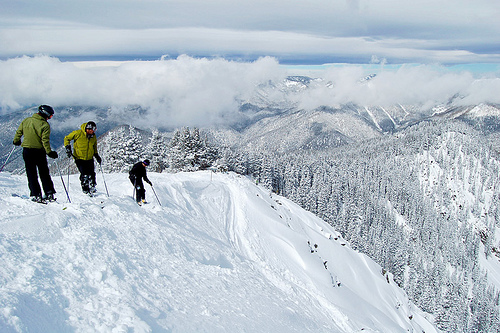
.
As of the 2010 census, there were 69 people counted as residents of the village. So when I moved here, the population increased nearly 1.5 percent!
Taos Ski Valley combines the founders’ Swiss/French/Austrian roots with the rich heritage of the area’s Native Americans. Known for its dramatic peaks, black steeps and deeps, remote chutes and long blue/green cruisers,Taos Ski Valley is rapidly gaining a reputation as the ultimate ski and snowboarding destination in North America.
The skiing and snowboarding here are intense – okay – Bad Ass. With over half the runs labeled Black Diamond or Double Black Diamond,Taos Ski Valley is world famous for its steep terrain, dry powder, and world-class skiers. Don’t believe the bad ass part? Check this out, filmed just days ago:
.
Here’s another clip that gives a flavor of the area. It’s a sneak preview of the movie “A Season in the Life” shot at the Log Mahal, Taos Ski Valley, and various backcountry locations:
But don’t worry, Taos Ski Valley isn’t just a resort for experts. It has many beginner and intermediate runs, and arguably the nation’s best ski school. It also has an excellent children’s day care and ski facility.
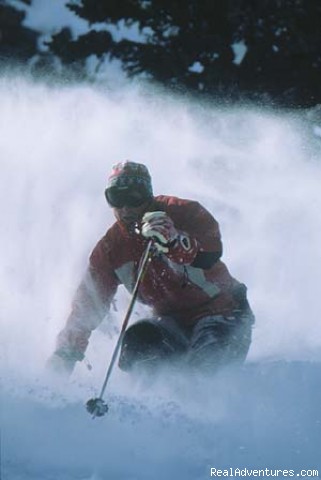
My favorite thing about skiing here? It’s a contrast from the above videos: The wilderness. The mountain’s solitude. The interaction with nature. There are no views of interstate highways, vast condominium communities, or golf courses designed by some retired pro.
With Kachina and Wheeler Peaks watching overhead, the only encounter you may have is with occasional wildlife. The only sound you may hear is that of your skis cutting through deep powder, or perhaps the internal sound of your heart pounding from the exhilaration of accelerating down the steep grade. Your mind now focused on maneuvering through the various runs of the mountain, forgetting your troubles, now so far away.
And when you reach the mountain’s bottom, you saunter into The Brown Bear Tavern and shout, “What’s for dinner? I’m starving!”
Après-Ski
And that’s where we come into play. With Après-Ski commencing daily at 2:00, nestle into one of the overstuffed chairs by the fireplace and sip on a Decadent Hot Chocolate or Hot Toddy. Enjoy crostini and crostone, or nibble on Native American pita bread – chemaith – served with black bean humus or spinach-artichoke dip. Or consider some prosciutto di Parma served with Navajo fry bread, fried little meatballs, or an international cheese plate.
.
Dinner
Our alpine comfort food revolves around classic dishes from the Alps: French Boeuf Bourguignon (country French stew), Bavarian Jägerschnitzel (paillard of chicken breast with wild mushroom sauce), Swiss Côte d’Agneau Doigts Brûlés (lamb chops from New Mexico’s Talus Wind Ranch), and Alto Adige’s Salmone con Salsina di Barbaforte (sautéed salmon with green apple horseradish sauce). Or how about an All-American Chicken Pot Pie topped with puff pastry?
.
Wine

We take our wine seriously, but with no pretense. And we took great care to create an offering that compliments the food and reflects our surroundings.
We bring some of Bellavitae’s Italian favorites from wineries such as Brancaia, Canella, Casanova di Neri, Jermann, and Vietti. Our French selections include Château la Grange Clinet, Louis Latour, Maison Joseph Douhin, Moët & Chandon, Olivier Savary, and Paul Jaboulet Aîné.
We also feature wines from New Mexico’s own Gruet Winery and Napa Valley’s Merryvale Vineyards. And if you’ve ever been skiing in the Alps, you expect to drink Austria’s Grüner Veltliner. We pour ours from Loimer.
.
Come and Enjoy
Spectacular scenery, interesting people, serious skiers, and rich cultural heritage. Add to the mix fabulous food and wine and you get, well, Taos Chic. We’ll continue to blog about our experience here in Taos Ski Valley, sharing recipes, wine notes, and cultural observations. Come join us. There’s a lot to experience.
.
Taos – An Ancient Community

Taos Pueblo The Taos Pueblo has been occupied for nearly a millennium. The pueblo was built between 1000 and 1450 A.D. and is the oldest continuously inhabited community in the United States.
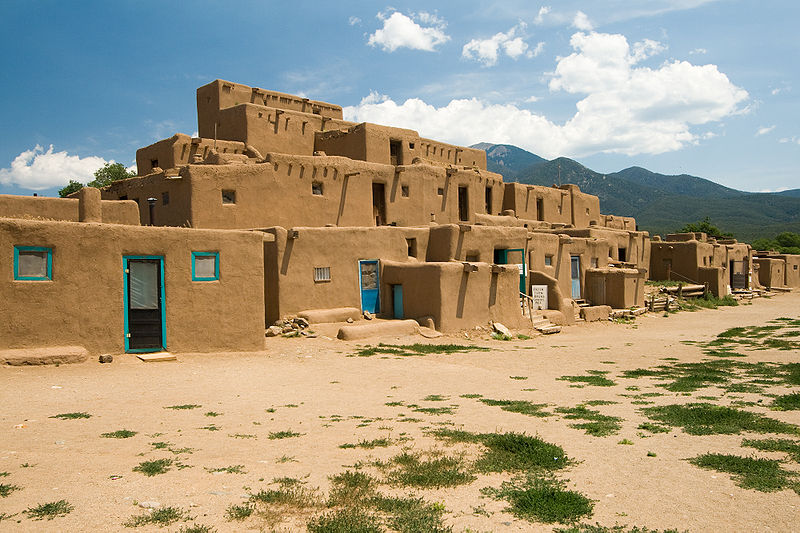
It is the most northern of the New Mexico pueblos and, at some places, is five stories high; composed of many individual homes with common walls. There are over 1,900 people in the Taos pueblo community. Some of them have modern homes near their fields, but there are about 150 people who live at the pueblo year-around.
Spanish Colonization Taos was established around 1615 as Fernandez de Taos, following the Spanish conquest of the Indian Pueblo villages. The relationship between the Spanish settlers and Taos Pueblo was initially amicable, but eventually turned sour, leading to a revolt in 1640; Taos Indians killed their priest and a number of Spanish settlers, and fled the pueblo, not returning until 1661.
In 1680, Taos Pueblo joined the widespread Pueblo Revolt. After the Spanish Reconquest of 1692, Taos Pueblo continued armed resistance to the Spanish until 1696, when Governor Diego de Vargas defeated the Indians at Taos Canyon.
During the 1770s, the Comanches of eastern Colorado repeatedly raided Taos. However, in 1779, Juan Bautista de Anza, governor of the Province of New Mexico, led a successful punitive expedition against the Comanches.
U.S. territory and statehood Mexico ceded the region to the U.S. in the Treaty of Guadalupe Hidalgo after the Mexican-American War. After the U.S. takeover of New Mexico in 1847, Hispanics and American Indians in Taos staged a rebellion, known as the Taos Revolt, in which the newly appointed U.S. Governor, Charles Bent, was killed. New Mexico became a territory of the United States in 1850 and reached statehood in 1912. The English name Taos derives from the native Taos language, meaning “place of red willows”.
Taos Art Colony Beginning in 1899, artists began to settle in Taos; six formed the Taos Society of Artists in 1915. In time, the Taos Art Colony developed. Many paintings were made of local scenes, especially of Taos Pueblo and activities there, as the artists often used Native Americans from the pueblo as models in their paintings. Some of the artists’ studios have been preserved, including the Ernest L. Blumenschein House, the Couse/Sharp Historic Site, and the Nicolai Fechin house. Influential later 20th-century Taos artists include R. C. Gorman and Agnes Martin.
“Via Con Me”
Paolo Conte live — Arena Di Verona
.
Kristen from Food Renegade does some top-notch research on that carton of “100% Orange Juice” that’s “not from concentrate” sitting in your refrigerator. The results are shocking, but not surprising:
When you make orange juice at home, each batch tastes a little different depending on the oranges you made it from.
Haven’t you ever wondered why every glass of Tropicana Pure Premium orange juice tastes the same, no matter where in the world you buy it or what time of year you’re drinking it in? Or maybe your brand of choice is Minute Maid or Simply Orange or Florida’s Natural. Either way, I can ask the same question. Why is the taste and flavor so consistent? Why is it that the Minute Maid never tastes like the Tropicana, but always tastes like its own unique beverage?
The reason your store bought orange juice is so consistently flavorful has more to do with chemistry than nature.
Here’s the skinny:
After the oranges are squeezed, the juice is stored in giant holding tanks and, critically, the oxygen is removed from them. That essentially allows the liquid to keep (for up to a year) without spoiling– but that liquid that we think of as orange juice tastes nothing like the Tropicana OJ that comes out of the carton.
In fact, it’s quite flavorless. So, the industry uses “flavor packs” to re-flavor the de-oxygenated orange juice. When the juice is stripped of oxygen it is also stripped of flavor providing chemicals. Juice companies therefore hire flavor and fragrance companies, the same ones that formulate perfumes for Dior and Calvin Klein, to engineer flavor packs to add back to the juice to make it taste fresh. Flavor packs aren’t listed as an ingredient on the label because technically they are derived from orange essence and oil. Yet those in the industry will tell you that the flavor packs, whether made for reconstituted or pasteurized orange juice, resemble nothing found in nature.
These flavor packs are simply by-products that originate in oranges, so they are considered an “ingredient,” even though they are chemically altered. What’s the point of drinking juice that is only palatable if it needs to be chemically altered? Okay, it’s convenient, it’s consistent, and it tastes good.
I’ve never been a fruit juice drinker, and here’s why: Fruit juice is high in sugar, devoid of healthy fiber, and high-priced relative to fruit. I think of fruit juice as a turbo-charged glucose and fructose injection, albeit with most of the vitamins left intact.
Drinking juice (or other sugar-loaded processed drinks) delivers sugar directly to the blood stream, which causes inflammation in our body’s cells, resulting in what scientists believe accelerates the aging process. Recent evidence links these sugars with several chronic ailments widely considered to be diseases of Western lifestyles — heart disease, hypertension, and many common cancers among them.
How many oranges (and the associated sugar content) are there in one glass of orange juice? Three to four. At 23 grams of sugar per orange (and 92 calories), one glass of juice has 69 more grams of sugar and 276 more calories than merely eating one juicy, satisfying orange.
Is drinking Tropicana or other processed orange juice that bad for you? Maybe not. But I contend that eating the whole fruit can slow down the intake of sugars into the blood stream because of the added fiber. Not only is eating the whole fruit better for you from a health perspective, but more enjoyable as well!
.
Further Reading:

.
Today’s brand-building through corporate-named stadiums and celebrity endorsements is nothing new. In fact, such marketing can be traced back to the Italian Renaissance. Virginia Postrel pens a fascinating article for Bloomberg that describes how “Renaissance art is full of status signals and calculated image-building — once-obvious messages that today’s tourists never notice.”
Plus this:
Brand-building through misleading images wasn’t invented on Madison Avenue or Hollywood. Many of Florence’s Renaissance treasures are monuments to exaggeration for the purposes of self-promotion. The medium may have changed, but the motives haven’t.
The Renaissance patrons who paid for all those frescoes, paintings, altar pieces and sculptures weren’t generally funding beauty for its own sake. They were buying status — building their brands, we’d say today. Their patronage showed off their wealth and piety and, in many cases, advertised their supposed links to the prestigious and powerful. In the process, these patrons often shaded the truth, leaving out unflattering facts and suggesting associations they didn’t in fact have.
I’ll never view Renaissance art in the same way again.
Read the whole thing.
.
Further Reading:
.
My son woke up every morning and fed his pigs, for six months. And after three months, he walked with the pigs, around in a circle, twice a day, to train the pig for the show. . .
All those unexpected obstacles did not faze my son. He stuck to what we practiced and did well at that. We showed his pigs three more times. Each time he got a little more confident. And I felt like my son was growing up, right in front of me. There is so much you can do to prepare for the world, but really, you grow only as you succeed or fail. You learn so much about yourself in that moment. . .
The guy who bought the pig is a guy who buys a lot of cattle from the Farmer. The guy who bought the pig is a farmer himself. He’ll eat the pork, for sure, but I’m sure he bought the pig because he believes in 4H and the county fair and what it teaches kids. And he believes we are part of the community, too: me and my sons and the Farmer.
We had 4H in Nebraska when I was a kid and I’m glad to hear it still plays a positive role not only in young people’s lives, but of entire communities. Funny how sometimes we don’t appreciate things like 4H until we grow older.
.
Theme: Food Express WordPress Food Theme is developed by Template Express.
Proudly powered by WordPress